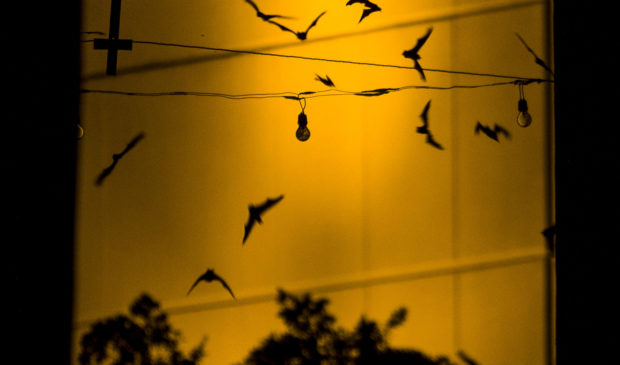Newsletter Signup
The Austin Monitor thanks its sponsors. Become one.
Most Popular Stories
- Austin opens new affordable housing development in Southeast Austin
- Landmark commission says goodbye to Nau’s Enfield Drug
- Congress Avenue transformation plan gets support from Urban Transportation Commission
- After a decline last year, Travis County homeowners should expect a return to rising property taxes
- Ethics complaints filed against Siegel, AURA
-
Discover News By District

White-nose syndrome has been found in Texas. Here’s what that means.
Friday, March 6, 2020 by Andrew Weber, KUT
Texas’ first case of white-nose syndrome in bats has been confirmed.
The fungus that causes the disease was first detected in Texas bats in 2017, but the disease itself, which has killed millions of bats on the East Coast, hadn’t been found by Texas Parks and Wildlife until Feb. 23 in Gillespie County.
Because of recent die-offs, Texas Parks and Wildlife is testing around 30 bats for white-nose syndrome in the Central Texas area. Results are pending.
White-nose syndrome, as the name suggests, comes from a fungus that grows on bats’ noses. It disrupts sleep cycles of hibernating bats while also emaciating them, so when they come out of hibernation, they’re weakened and can easily starve. In some colder climates, the disease has led to declines of up to 90 percent of bat populations.

If or when it spreads, Nate Fuller of Texas Parks and Wildlife says, the disease will most affect bats living in caves. But that doesn’t mean white-nose syndrome ends there. Practically speaking, a die-off of bats could have far-reaching effects on agriculture in Texas.
Bats tend to feed on moths and beetles, insects with breeding cycles that can stunt or even jeopardize harvests, he said.
“These are the kinds of bugs that will lay eggs, and their juvenile phases will consume a lot of crops to the point where it causes farmers to use more pesticides and things like that on their crops to make sure that their plants stay viable until harvest season,” Fuller said. “So without bats, we have a significant increase in the amount of pesticides and other nasty chemicals that we have to spray onto our agriculture.”
The disease will not immediately affect Austin’s bats, which are Mexican free-tailed bats. Fuller says they are more likely to be vectors of the disease, rather than victims, because their hibernation isn’t as extensive as it is among cave bats, and they don’t spend their winters in colder climates.
“We suspect that the bats in Austin should be safe,” he said. “But those guys can also move the fungus around quite a bit, because they’re wide-ranging animals that can fly 70 kilometers each night when they go to feed.”
On top of that, Fuller says, the department’s rabies lab has also seen a spike in the number of bats suspected of having rabies. In any given February, Fuller says, the lab will get two bats to test for rabies. Last month, it tested 60.
Fuller emphasized that bats infected with white-nose syndrome are not aggressive or harmful and that the disease doesn’t affect humans. Rabid bats could transmit rabies, however.
He urges people who encounter a bat acting erratically to leave it alone and call Texas Parks and Wildlife or their local public health department. Austinites who find orphaned or injured bats may also contact Austin Bat Refuge.
This story was produced as part of the Austin Monitor’s reporting partnership with KUT. Photo by Gabriel C. Pérez/KUT. Map credit: Texas Parks and Wildlife Department.
The Austin Monitor’s work is made possible by donations from the community. Though our reporting covers donors from time to time, we are careful to keep business and editorial efforts separate while maintaining transparency. A complete list of donors is available here, and our code of ethics is explained here.
You're a community leader
And we’re honored you look to us for serious, in-depth news. You know a strong community needs local and dedicated watchdog reporting. We’re here for you and that won’t change. Now will you take the powerful next step and support our nonprofit news organization?








